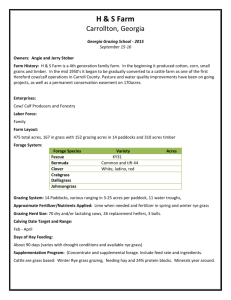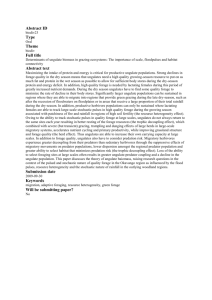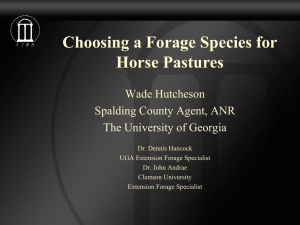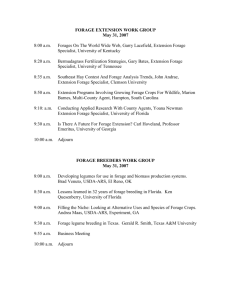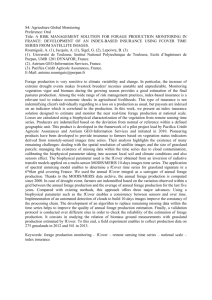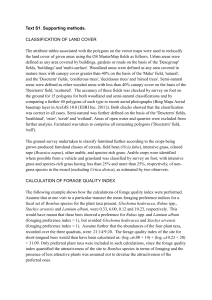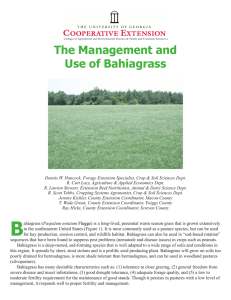Forage Production Calendar for Northeast Florida
advertisement
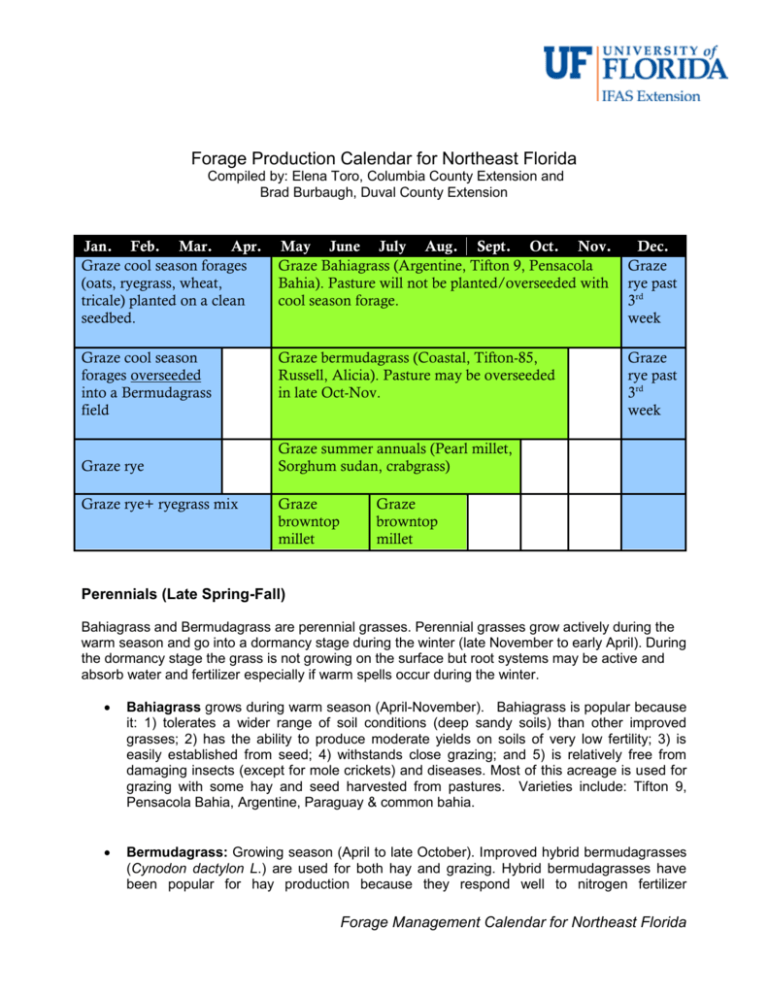
Forage Production Calendar for Northeast Florida Compiled by: Elena Toro, Columbia County Extension and Brad Burbaugh, Duval County Extension Jan. Feb. Mar. Apr. Graze cool season forages (oats, ryegrass, wheat, tricale) planted on a clean seedbed. May June July Aug. Sept. Oct. Nov. Graze Bahiagrass (Argentine, Tifton 9, Pensacola Bahia). Pasture will not be planted/overseeded with cool season forage. Dec. Graze rye past 3rd week Graze cool season forages overseeded into a Bermudagrass field Graze bermudagrass (Coastal, Tifton-85, Russell, Alicia). Pasture may be overseeded in late Oct-Nov. Graze rye past 3rd week Graze rye Graze rye+ ryegrass mix Graze summer annuals (Pearl millet, Sorghum sudan, crabgrass) Graze browntop millet Graze browntop millet Perennials (Late Spring-Fall) Bahiagrass and Bermudagrass are perennial grasses. Perennial grasses grow actively during the warm season and go into a dormancy stage during the winter (late November to early April). During the dormancy stage the grass is not growing on the surface but root systems may be active and absorb water and fertilizer especially if warm spells occur during the winter. Bahiagrass grows during warm season (April-November). Bahiagrass is popular because it: 1) tolerates a wider range of soil conditions (deep sandy soils) than other improved grasses; 2) has the ability to produce moderate yields on soils of very low fertility; 3) is easily established from seed; 4) withstands close grazing; and 5) is relatively free from damaging insects (except for mole crickets) and diseases. Most of this acreage is used for grazing with some hay and seed harvested from pastures. Varieties include: Tifton 9, Pensacola Bahia, Argentine, Paraguay & common bahia. Bermudagrass: Growing season (April to late October). Improved hybrid bermudagrasses (Cynodon dactylon L.) are used for both hay and grazing. Hybrid bermudagrasses have been popular for hay production because they respond well to nitrogen fertilizer Forage Management Calendar for Northeast Florida applications, have high yield potential and usually dry or cure faster than most other forages that could be used for hay. Overseeding winter forages into a pasture has generally been more successful on bermudagrasses than on bahiagrasses. Many research studies have shown high animal weight gains when bermudagrass is well fertilized. Recommendations to maximize longevity and quality of Bahiagrass and Bermudagrass pastures include: Proper establishment: Conduct soil test to monitor pH and nutrient concentration before planting. Bahiagrass: Use certified seed and recommended seeding rate. New stands must be fertilized using split fertilizer applications. Conduct first fertilization to ensure growth as soon as seedlings have reached 4-5 inches. For more information regarding fertilizing bahiagrass refer to your soil test results and contact your county agent. If weeds are a problem mow stand when plants have reached 6 inches tall. Bermudagrass: Use recommended tonnage plant material for sprigging, do not let plant material be exposed to the sun before planting. Conduct weed control in the first 10 days and apply fertilizer based on soil test recommendations after sprigging. Start grazing in the pasture once plants have developed a good root system (may take several months) and grass has covered pasture. Do not overgraze: Ideally a good rule of thumb is that animals weighing the equivalent of 1,000 lbs can graze 2. 5 acres. Once you exceed the number of animals allowable considering this parameter the pasture is overstocked. Do not overstock your pastures or use high stocking rates especially if you have limited pasture area (less than 10 acres of well established pasture). Rotate pastures: Allow grass a “resting period” for forage to grow back. The resting period should ideally be between 14 and 21 days. As a result, livestock will be able to graze a pasture when grass is at its highest nutritional quality. After day 35 of re-growth Bahia and Bermudagrasses will have lost a considerable amount of crude protein concentration in the leaves, TDN will be lower and stems and leaves will become very fibrous. Conduct a soil test at least every 2 years to monitor pH and nutrients in the soil. After a severe drought like the one we experienced this past year do not overgraze fields. Forage Management Calendar for Northeast Florida Summer Annual Grasses Summer annual forages adapted to Northeast Florida can be higher quality than bahiagrass. However, these need to be managed and rotationally grazed in order to extend the grazing season as they do not withstand overgrazing. Nitrogen applications are essential to maintain productivity of crop but producers need to excise caution if periods of extended drought occur once stands have been fertilized. Crabgrass is an annual grass, and reseeds itself year after year, if managed to allow the plant to flower and produce seed during the previous season. Planting crabgrass fits well in open land situations where planting annual winter forages, such as ryegrass, oats, rye or wheat, for early grazing is the goal. The periods for winter annuals and crabgrass are complementary and allow for slight overlap in seasonal forage production. Shallow tillage prior to planting winter annuals will incorporate crabgrass seed and usually results in good crabgrass stands the following spring, without the need for spring tillage. However, to ensure early spring growth of crabgrass, a producer can shallowly disk the winter annual forage (about 3 inches deep) once production has declined significantly in spring, and a new crabgrass stand will normally appear, assuming there is an ample quantity of crabgrass seed in the soil. When the crabgrass stand is established, fertilization is the primary management practice required. Crabgrass growth declines by late August or early September. Crabgrass forage has excellent quality and palatability, but yield is variable and is dependent on soil fertility and rainfall. The forage quality of crabgrass is typically better than that of most other summer grasses. For example, crabgrass hay is usually of higher quality than that of bermudagrass, bahiagrass, or more commonly planted summer annual grasses such as pearl millet or sorghum-sudan hybrids. Pearl millet (Pennisetum americanum) and sorghum-sudan hybrids (Sorghum x drummondii), are warm-season, rapidly growing, high-yielding, high-quality, annual grasses. They are often planted following small grains, a spring vegetable crop, or some other cultivated crop. Occasionally they may be planted in a pasture renovation program, where the perennial grass is destroyed and the area is planted with the annual grass. These annual grasses are usually grazed by animals that need high-quality forage. Pearl millet and sorghum-sudan hybrids are excellent creep pasture. The earliest planting date in north Florida should be around April 1. Soil temperature must be warm before planting since seed germination and seedling growth are very sensitive to cool soil conditions. A late summer planting could be made in south Florida or midsummer in north Florida for a single fall grazing or harvest. Regrowth from late plantings is less than from earlier plantings. Both pearl millet and sorghum-sudan hybrids can be broadcast, drilled, or planted in rows. The seeding rate for broadcast plantings is 24 to 30 pounds per acre. The seeding rate can be reduced for drilled and row plantings. A low seeding rate or poor stand may not be a disaster since many varieties have excellent tillering capability and can fill in voids. With the early planting dates, the bulk of the forage is produced from June through August. Producers should be prepared to graze pearl millet rotationally. Millet should reach a height of 14 to 24 inches before each grazing period. Try to graze each pasture down to 6 to 8 inches in one to three days. After a pasture has been grazed, allow it to regrow to a 14 to 24 inch height before regrazing. When plants start to form heads, removing heads by mowing may prolong vegetative growth. Forage Management Calendar for Northeast Florida Japanese millet (Echinochloa crus-galli var. frumentacea) grows 2 to 4 feet tall. It should not be confused with pearl millet. It matures quickly, and thus its forage yield is much less than that of pearl millet. A named variety, Chawapa, grows taller and produces more forage than the common japanese millet. Japanese millet is sometimes seeded with a new planting of bahiagrass to furnish an early grazing or seed crop. Be careful to not let the millet shade out the bahiagrass seedlings. Japanese millet is also planted for wildlife feed and for temporary soil stabilization on construction sites. Browntop millet (Panicum ramosum) is similar to japanese millet in growth habit and use. It is an excellent seed producer. Browntop millet produces lower forage yields than pearl millet, resulting in less forage. It can be used for grazing. Browntop millet can become a pest if planted on row-crop land because of its reseeding ability and long period of seed viability in the soil. Browntop millet is best seeded by broadcasting at 20 to 25 pounds per acre on a prepared seedbed in late April or early May. Browntop millet is ready to be grazed in 20-25 days after planting but will usually only last 60 days. Used to fill gaps between cool and warm season forage availability. Prosso millet (Panicum miliaceum) is a bit more cold tolerant than browntop millet but has similar uses. Sudangrass (Sorghum x drummondii) is similar to the sorghum-sudan hybrids but is shorter and has finer stems. Yields are lower than the sorghum-sudan hybrids. Production, management, and utilization practices are the same as for sorghum-sudan hybrids. Cool Season Forages Ryegrass. Annual ryegrass (Lolium multiflorum) is a bunch grass that tillers profusely and has dark green, shiny, smooth leaves. It tolerates wet, poorly drained soils better than the small grains, is somewhat tolerant of moderate soil acidity, and is very responsive to nitrogen fertilization. The peak season of growth is later than that of rye, and a mixture of rye and ryegrass is widely used by cattlemen since it extends the grazing period of either forage planted alone. Ryegrass produces high-quality forage, tolerates close, continuous grazing, and gives excellent animal performance. It is mostly used as a grazing crop but may be used for hay or silage. Since some varieties do reseed well, ryegrass could become a pest plant in certain situations. Rye is the most widely used of the small grains as a winter grazing crop. It is more tolerant of cold weather and soil acidity and generally produces more forage than other small grains. For these reasons, rye is generally considered to be the "most dependable" of the small grains as a forage crop. It is used mainly as a grazing crop and performs especially well with ryegrass as a companion crop to give a longer grazing season than either alone. If planted too early (before cool weather begins) seedling diseases often result in poor stands. Rye varieties developed in northern states are more cold-weather dormant and thus produce little forage in late fall to early winter. Northern varieties are often severely damaged by leaf diseases, compared to southern developed varieties selected for improved disease resistance. Forage Management Calendar for Northeast Florida Oats are generally the most cold-sensitive of the small grains, and in some years stand loss from severe cold greatly reduces forage growth, resulting in less available grazing. Oats may be planted earlier than the other small grains and thus may provide grazable forage earlier. Oats may be used for grazing, hay, or silage. Wheat is very similar to oats in forage yield but less susceptible to cold injury. Wheat may be used for grazing, hay, or silage. Only varieties resistant to Hessian fly should be planted. Wheat cannot be planted as early as oats, but wheat may provide more forage later into the spring than either oats or rye. Triticale is a relatively new crop--a "man-made" crop resulting from a cross between wheat and rye. It is very similar to wheat and is used similarly. Some varieties have been developed especially for grazing. Barley is not generally used as a forage crop in Florida. Notes When overseeding forage production is delayed and total forage production is less; however, overseeding has advantages for some producers. When planted on a clean-tilled seedbed with rye, ryegrass seedlings are very competitive, which allows them to survive the early competition from the fast-growing rye plants when planted as a mixture. The rye grows relatively fast in the fall, which provides grazing in early winter, but declines in growth in late winter as ryegrass begins its accelerated growth phase. Ryegrass production may last until late May to early June, depending on soil moisture and nitrogen management. Overseeding bahiagrass fields is not a very successful practice in most deep sandy soils in Northeast Florida. Cool season forages will be in direct competition for water and fertilizer with the dormant grass. Yield reduction can be dramatic in fields overseeded with oats, rye and ryegrass if the bahiagrass or bermudagrass starts greening up in the middle of the winter. References For more information on the forage crops outlined in this document refer to the following EDIS Publications available from UF/IFAS Extension. Soil Testing Gerald Kidder and R.D.Rhue http://edis.ifas.ufl.edu/SS156 Bahiagrass Y.C. Newman http://edis.ifas.ufl.edu/AG271 Bermudagrass Production in Florida C. G. Chambliss, F. A. Johnson, and M. B. Adjei http://edis.ifas.ufl.edu/AA200 Forage Management Calendar for Northeast Florida Planting Dates, Rates, and Methods of Agronomic Crops E. B. Whitty and C. G. Chambliss http://edis.ifas.ufl.edu/AA127 Crabgrass as a Forage and Hay Crop A.R. Blount, D.M. Ball, R.K. Sprenkel, R.O. Myer, and T.D. Hewitt http://edis.ifas.ufl.edu/AG195 Producing Millets and Sorghums C. G. Chambliss and M. B. Adjei http://edis.ifas.ufl.edu/AG157 Tillage and Overseeding Pastures for Winter Forage Production in North Florida D.L. Wright, A.R. Blount, R.D. Barnett, and R.O. Myer http://edis.ifas.ufl.edu/AG146 2007 Fall Forage Update R. Blount, R. D. Barnett, G. M. Prine, K. H. Quesenberry and Y.C. Newman http://edis.ifas.ufl.edu/AA266 Forage Management Calendar for Northeast Florida
